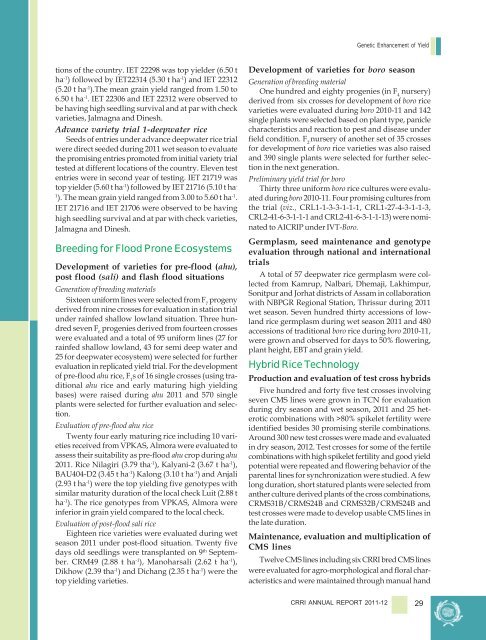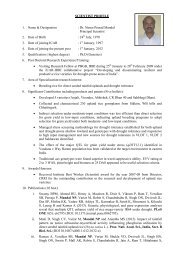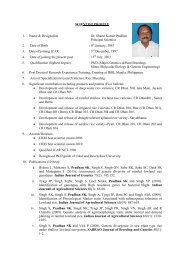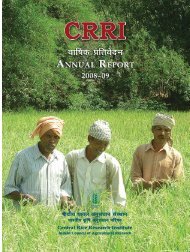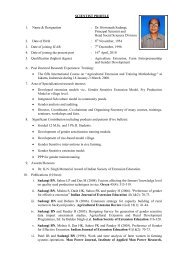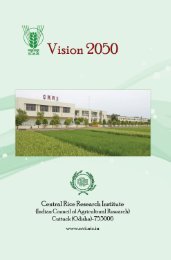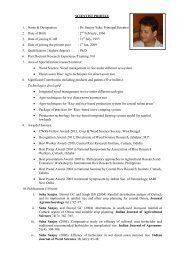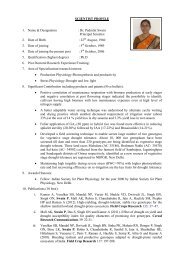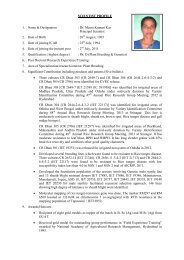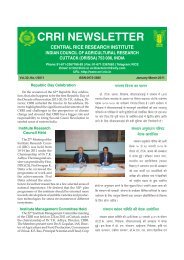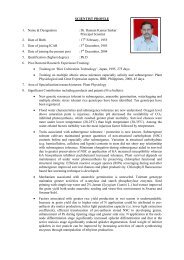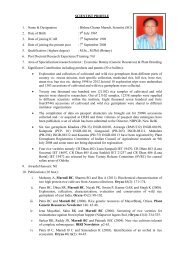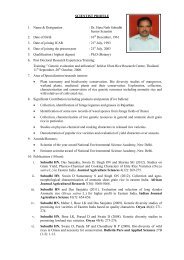Central Rice Research Institute Annual report...2011-12
Central Rice Research Institute Annual report...2011-12
Central Rice Research Institute Annual report...2011-12
You also want an ePaper? Increase the reach of your titles
YUMPU automatically turns print PDFs into web optimized ePapers that Google loves.
Genetic Enhancement of Yield<br />
tions of the country. IET 22298 was top yielder (6.50 t<br />
ha -1 ) followed by IET22314 (5.30 t ha -1 ) and IET 223<strong>12</strong><br />
(5.20 t ha -1 ).The mean grain yield ranged from 1.50 to<br />
6.50 t ha -1 . IET 22306 and IET 223<strong>12</strong> were observed to<br />
be having high seedling survival and at par with check<br />
varieties, Jalmagna and Dinesh.<br />
Advance variety trial 1-deepwater rice<br />
Seeds of entries under advance deepwater rice trial<br />
were direct seeded during 2011 wet season to evaluate<br />
the promising entries promoted from initial variety trial<br />
tested at different locations of the country. Eleven test<br />
entries were in second year of testing. IET 21719 was<br />
top yielder (5.60 t ha -1 ) followed by IET 21716 (5.10 t ha -<br />
1<br />
). The mean grain yield ranged from 3.00 to 5.60 t ha -1 .<br />
IET 21716 and IET 21706 were observed to be having<br />
high seedling survival and at par with check varieties,<br />
Jalmagna and Dinesh.<br />
Breeding for Flood Prone Ecosystems<br />
Development of varieties for pre-flood (ahu),<br />
post flood (sali) and flash flood situations<br />
Generation of breeding materials<br />
Sixteen uniform lines were selected from F 7<br />
progeny<br />
derived from nine crosses for evaluation in station trial<br />
under rainfed shallow lowland situation. Three hundred<br />
seven F 6<br />
progenies derived from fourteen crosses<br />
were evaluated and a total of 95 uniform lines (27 for<br />
rainfed shallow lowland, 43 for semi deep water and<br />
25 for deepwater ecosystem) were selected for further<br />
evaluation in replicated yield trial. For the development<br />
of pre-flood ahu rice, F 1<br />
s of 16 single crosses (using traditional<br />
ahu rice and early maturing high yielding<br />
bases) were raised during ahu 2011 and 570 single<br />
plants were selected for further evaluation and selection.<br />
Evaluation of pre-flood ahu rice<br />
Twenty four early maturing rice including 10 varieties<br />
received from VPKAS, Almora were evaluated to<br />
assess their suitability as pre-flood ahu crop during ahu<br />
2011. <strong>Rice</strong> Nilagiri (3.79 tha -1 ), Kalyani-2 (3.67 t ha -1 ),<br />
BAU404-D2 (3.45 t ha -1 ) Kalong (3.10 t ha -1 ) and Anjali<br />
(2.93 t ha -1 ) were the top yielding five genotypes with<br />
similar maturity duration of the local check Luit (2.88 t<br />
ha -1 ). The rice genotypes from VPKAS, Almora were<br />
inferior in grain yield compared to the local check.<br />
Evaluation of post-flood sali rice<br />
Eighteen rice varieties were evaluated during wet<br />
season 2011 under post-flood situation. Twenty five<br />
days old seedlings were transplanted on 9 th September.<br />
CRM49 (2.88 t ha -1 ), Manoharsali (2.62 t ha -1 ),<br />
Dikhow (2.39 tha -1 ) and Dichang (2.35 t ha -1 ) were the<br />
top yielding varieties.<br />
Development of varieties for boro season<br />
Generation of breeding material<br />
One hundred and eighty progenies (in F 4<br />
nursery)<br />
derived from six crosses for development of boro rice<br />
varieties were evaluated during boro 2010-11 and 142<br />
single plants were selected based on plant type, panicle<br />
characteristics and reaction to pest and disease under<br />
field condition. F 2<br />
nursery of another set of 35 crosses<br />
for development of boro rice varieties was also raised<br />
and 390 single plants were selected for further selection<br />
in the next generation.<br />
Preliminary yield trial for boro<br />
Thirty three uniform boro rice cultures were evaluated<br />
during boro 2010-11. Four promising cultures from<br />
the trial (viz., CRL1-1-3-3-1-1-1, CRL1-27-4-3-1-1-3,<br />
CRL2-41-6-3-1-1-1 and CRL2-41-6-3-1-1-13) were nominated<br />
to AICRIP under IVT-Boro.<br />
Germplasm, seed maintenance and genotype<br />
evaluation through national and international<br />
trials<br />
A total of 57 deepwater rice germplasm were collected<br />
from Kamrup, Nalbari, Dhemaji, Lakhimpur,<br />
Sonitpur and Jorhat districts of Assam in collaboration<br />
with NBPGR Regional Station, Thrissur during 2011<br />
wet season. Seven hundred thirty accessions of lowland<br />
rice germplasm during wet season 2011 and 480<br />
accessions of traditional boro rice during boro 2010-11,<br />
were grown and observed for days to 50% flowering,<br />
plant height, EBT and grain yield.<br />
Hybrid <strong>Rice</strong> Technology<br />
Production and evaluation of test cross hybrids<br />
Five hundred and forty five test crosses involving<br />
seven CMS lines were grown in TCN for evaluation<br />
during dry season and wet season, 2011 and 25 heterotic<br />
combinations with >80% spikelet fertility were<br />
identified besides 30 promising sterile combinations.<br />
Around 300 new test crosses were made and evaluated<br />
in dry season, 20<strong>12</strong>. Test crosses for some of the fertile<br />
combinations with high spikelet fertility and good yield<br />
potential were repeated and flowering behavior of the<br />
parental lines for synchronization were studied. A few<br />
long duration, short statured plants were selected from<br />
anther culture derived plants of the cross combinations,<br />
CRMS31B/CRMS24B and CRMS32B/CRMS24B and<br />
test crosses were made to develop usable CMS lines in<br />
the late duration.<br />
Maintenance, evaluation and multiplication of<br />
CMS lines<br />
Twelve CMS lines including six CRRI bred CMS lines<br />
were evaluated for agro-morphological and floral characteristics<br />
and were maintained through manual hand<br />
CRRI ANNUAL REPORT 2011-<strong>12</strong><br />
29


